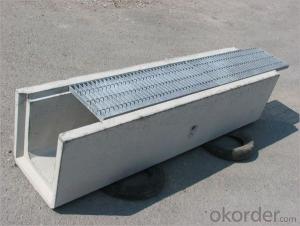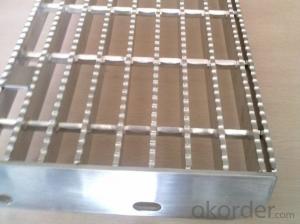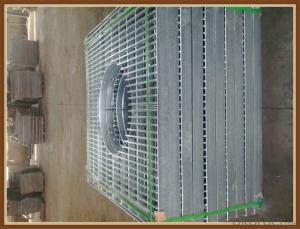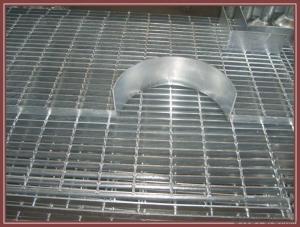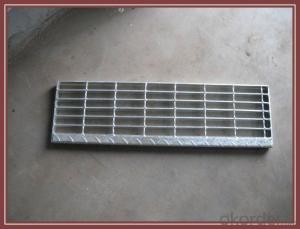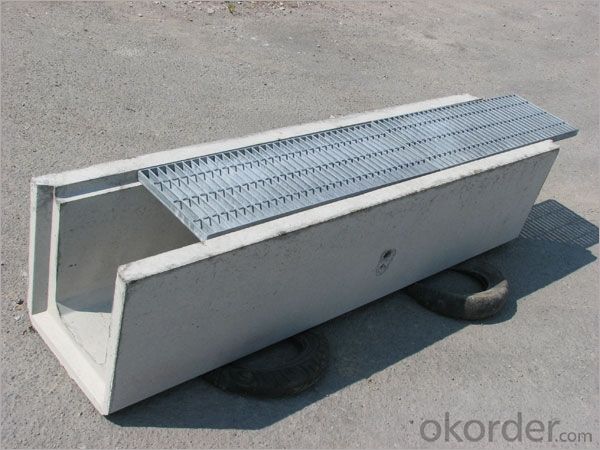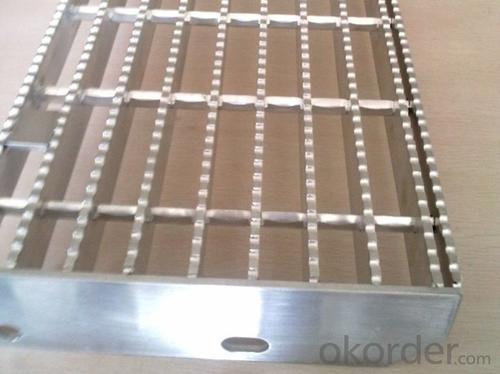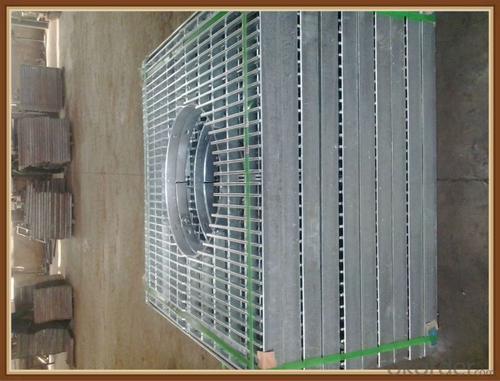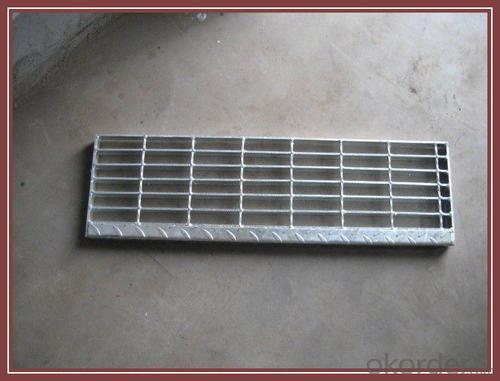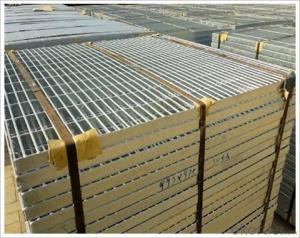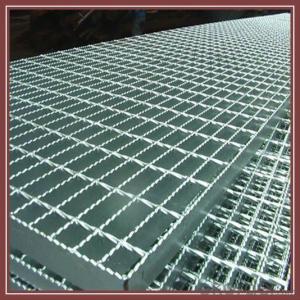Aluminum Sheets for Ceilings - Aluminum Gratings/Grid Platform for Work Step
- Loading Port:
- Qingdao
- Payment Terms:
- TT OR LC
- Min Order Qty:
- 5000 pc
- Supply Capability:
- 6000000 pc/month
OKorder Service Pledge
OKorder Financial Service
You Might Also Like
1.Description of Drainage trench cover:
Drainage trench cover is widely used in the urban road, the square, the botanical garden, the wharf, the airport, the parking lot, the road, each kind of industry, the civil project, etc.
2.Main features of Drainage trench cover:
I--Carrying 20 tons of weight
II—Carrying 14 tons of weight
III---carrying 6 tons of weight
IV---carrying 2 tons of weight
V---Carrying pedestrian weight
3.Glass Wool Blanket Images:
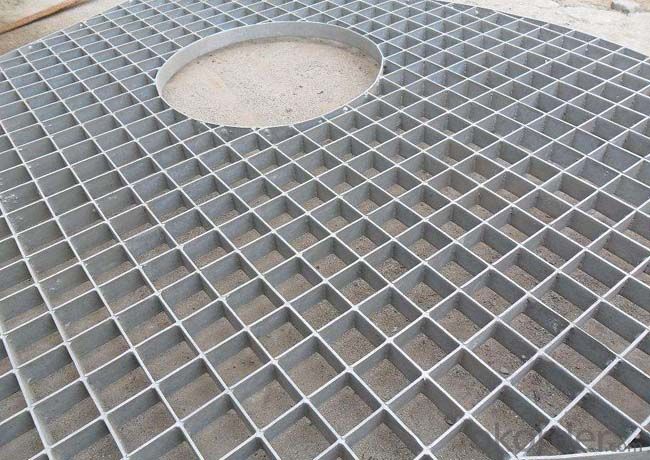
4. Drainage Trench Cover Technical Parameters:
These drain cover plate applies to the road cross-sectional and longitudinal drain. The drains width ranging from 200mm to 550mm.
A means the steel grating length
H means the steel grating height
A means the frame length
H means the frame height
5.FAQ
We have organized several common questions for our clients,may help you sincerely:
①How about your company?
A world class manufacturer & supplier of Drainage trench cover is
one of the large scale professional investment casting production bases in China,consisting of both casting foundry forging and machining factory. Annually more than 8000 tons Precision casting and forging parts are exported to markets in Europe,America and Japan. OEM casting and forging service available according to customer’s requirement.
②How to guarantee the quality of the products?
We have established the international advanced quality management system every link from raw material to final product we have strict quality test; We resolutely put an end to unqualified products flowing into the market. At the same time, we will provide necessary follow-up service assurance.
- Q: This question asks for a comparison between aluminum sheets and other roofing materials in terms of their characteristics and performance.
- <p>Aluminum sheets are lightweight and highly durable, offering excellent resistance to corrosion and weathering. They are energy-efficient, reflecting heat and reducing cooling costs. Compared to materials like asphalt shingles, aluminum is more expensive but lasts longer, with a lifespan of 40-50 years. Unlike clay or concrete tiles, aluminum is less prone to breakage and is easier to install. It also doesn't rot or warp like wood, and it's fire-resistant. However, it can be noisy during rain and is less visually appealing than some other materials, but its modern and sleek appearance can be a design advantage.</p>
- Q: This question asks for a list of various coatings that can be applied to aluminum sheets for different purposes.
- <p>Aluminum sheets can be coated with a variety of materials to enhance their properties such as durability, appearance, and corrosion resistance. Some common types of coatings include: 1. Anodizing: Creates a protective oxide layer on the aluminum surface. 2. Powder Coating: A dry coating that is electrostatically applied and then cured at high temperatures. 3. PVDF (Polyvinylidene Fluoride) Coating: Known for its excellent resistance to UV, chemicals, and weathering. 4. Epoxy Coating: Provides a hard, durable finish that is resistant to chemicals and corrosion. 5. Polyester Coating: Offers good adhesion and is often used for outdoor applications. 6. Fluorocarbon Coating: Provides a high level of durability and resistance to weathering. 7. Ceramic Coating: A newer type of coating that offers excellent heat resistance and a smooth finish. These coatings are chosen based on the specific requirements of the application, such as architectural, automotive, or aerospace uses.</p>
- Q: Explain how aluminum sheets impact the soundproofing capabilities of a building.
- <p>Aluminum sheets can have a significant impact on the sound insulation of a building. They are often used as a cladding material due to their durability and low maintenance requirements. However, aluminum is a good conductor of sound, which means it can transmit sound waves efficiently. This can reduce the sound insulation of a building, especially if the aluminum sheets are not combined with other soundproofing materials. To improve sound insulation, aluminum sheets can be combined with insulation materials, such as polyurethane foam, to create a barrier that reduces sound transmission. Additionally, using thicker aluminum sheets or adding a layer of sound-absorbing material can help enhance the soundproofing capabilities of a building.</p>
- Q: Are aluminum sheets suitable for soundproofing applications?
- Aluminum sheets are indeed suitable for soundproofing applications. Their sound-blocking properties are commendable and aid in diminishing noise transmission when utilized for soundproofing purposes. Being lightweight, they can be effortlessly installed as barriers or panels, effectively creating a sound barrier between different areas or isolating specific equipment or machinery. Moreover, combining aluminum sheets with other soundproofing materials like foam or rubber can further amplify their soundproofing capabilities. However, it is crucial to acknowledge that the thickness and density of the aluminum sheets significantly determine their soundproofing effectiveness. Thicker and denser sheets offer superior sound insulation in contrast to thinner ones. Additionally, factors such as the design, construction, and installation of the soundproofing system also influence its overall efficacy in reducing noise.
- Q: Can aluminum sheet be used for automotive body-in-white applications?
- Certainly, automotive body-in-white applications can utilize aluminum sheet. Aluminum possesses the advantageous qualities of being lightweight, robust, and long-lasting, rendering it an optimal substance for automotive purposes. It presents a remarkable strength-to-weight ratio, which contributes to enhancing fuel efficiency and overall vehicle performance. Furthermore, aluminum excels in resisting corrosion, enabling it to endure harsh environmental conditions. Its malleability permits the creation of intricate and sophisticated designs, empowering manufacturers to fabricate automotive structures that are simultaneously light and sturdy. In recent times, the utilization of aluminum in automotive body-in-white applications has gained considerable popularity, primarily due to its ability to decrease vehicle weight and emissions while simultaneously maximizing safety and performance.
- Q: What are the common surface finishes for aluminum sheets?
- Some common surface finishes for aluminum sheets include mill finish, brushed finish, anodized finish, and powder-coated finish. Mill finish refers to the untreated surface of the aluminum sheet, which has a slightly rough texture and may have visible imperfections. This is the most basic and economical option, commonly used for industrial applications or as a base for further finishing processes. Brushed finish involves a mechanical brushing process that creates a series of fine parallel lines on the surface of the aluminum sheet. This finish gives the metal a textured appearance and can help to hide small scratches or imperfections. Anodized finish is achieved through an electrochemical process called anodization, which creates a protective oxide layer on the surface of the aluminum. This finish enhances the corrosion resistance and durability of the metal while also allowing for a variety of color options. Anodized aluminum sheets are often used in architectural applications or for decorative purposes. Powder-coated finish involves applying a dry powder to the surface of the aluminum sheet and then baking it at high temperatures. This process creates a durable and attractive finish that is resistant to chipping, scratching, and fading. Powder-coated aluminum sheets are commonly used for outdoor applications, such as building facades, signage, or automotive parts. Overall, the choice of surface finish for aluminum sheets depends on the desired appearance, functionality, and specific requirements of the application.
- Q: This question asks for a comparison between aluminum sheets and other lightweight materials like plastic and glass, focusing on their properties and uses.
- <p>Aluminum sheets are lightweight yet strong, offering excellent strength-to-weight ratios. They are more durable and heat resistant compared to plastics, which can deform under heat and are less sturdy. Unlike glass, aluminum is less brittle and does not shatter, making it safer for certain applications. Additionally, aluminum is recyclable and has good thermal and electrical conductivity, which is not the case with plastics. However, plastics are generally cheaper and easier to shape into complex forms, while glass offers better transparency for applications requiring clear visibility. Each material has its advantages depending on the specific requirements of the application.</p>
- Q: Can aluminum sheets handle high temperatures?
- Certainly! High temperatures are well-tolerated by aluminum sheets. With a melting point of 660 degrees Celsius (1220 degrees Fahrenheit), aluminum proves itself suitable for various applications requiring elevated temperatures. Furthermore, aluminum possesses exceptional thermal conductivity, enabling rapid heat dissipation. This attribute renders aluminum sheets ideal for deployment in environments necessitating resistance against high temperatures, including engine components, heat exchangers, and oven linings. Nevertheless, it is crucial to take into account the specific alloy and thickness of the aluminum sheet, as different alloys may impose different temperature thresholds.
- Q: Can aluminum sheet be used for electrical conductivity applications?
- No, aluminum sheet can be used for electrical conductivity applications. Aluminum is a highly conductive metal, second only to copper in terms of electrical conductivity. It is commonly used in electrical wiring, power transmission lines, and electrical components. Aluminum sheets can be used in applications where electrical conductivity is required, such as in the construction of electrical panels, bus bars, and heat sinks. However, it is important to note that the thickness and purity of the aluminum sheet can affect its conductivity, so these factors should be considered when choosing the appropriate aluminum sheet for a specific electrical application.
- Q: What are the different types of alloys used in aluminum sheets?
- Aluminum sheets utilize a variety of alloys, each possessing distinct properties and advantages. The following are some commonly employed alloys: 1. The 3003 alloy offers exceptional formability, corrosion resistance, and weldability, making it suitable for general-purpose use. It finds applications in cooking utensils, signage, and chemical equipment. 2. Known for its high strength and good corrosion resistance, the 5052 alloy is frequently utilized in marine and automotive fields. It is also employed in sheet metal fabrication and structural components. 3. The 6061 alloy is highly versatile and finds application in several sectors such as aerospace, automotive, and structural components. It provides excellent strength, machinability, and weldability. 4. Primarily used in aerospace and high-strength applications, the 7075 alloy boasts an exceptional strength-to-weight ratio. It is commonly employed in aircraft fittings, gears, and bike frames. 5. The 2024 alloy, popular in aerospace applications, exhibits a high strength-to-weight ratio and excellent fatigue resistance. It is commonly used for aircraft structures, bolts, and rivets. 6. The 5083 alloy, specifically designed for marine applications, showcases outstanding corrosion resistance and high strength. It is frequently utilized for boat hulls and structural components. These are merely a few instances of the diverse alloys employed in aluminum sheets. Each alloy possesses a unique combination of properties that enable it to excel in specific applications.
Send your message to us
Aluminum Sheets for Ceilings - Aluminum Gratings/Grid Platform for Work Step
- Loading Port:
- Qingdao
- Payment Terms:
- TT OR LC
- Min Order Qty:
- 5000 pc
- Supply Capability:
- 6000000 pc/month
OKorder Service Pledge
OKorder Financial Service
Similar products
Hot products
Hot Searches
Related keywords
